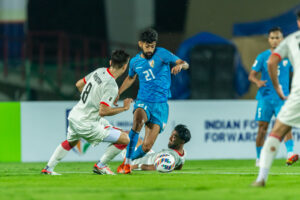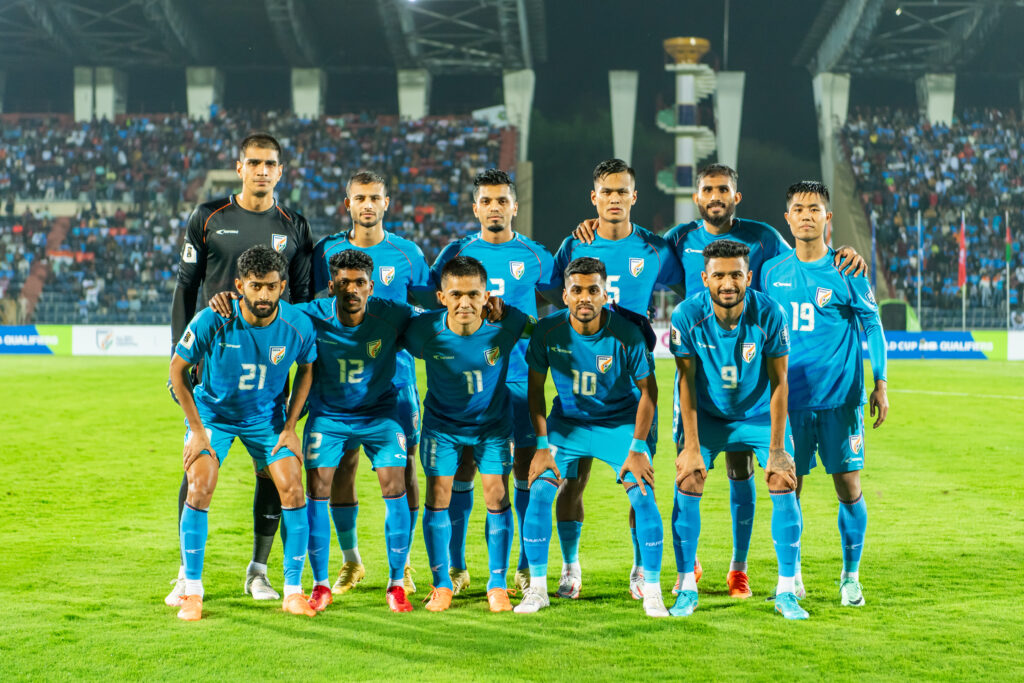
Last year, on March 28, India’s men’s football team embarked on a dream run, clinching three titles consecutively – the Tri-Nation Cup, Intercontinental Cup, and SAFF Cup – on home turf. However, nearly a year later, on March 26, the same team faced boos from fans following a disastrous 2-1 defeat to Afghanistan in Guwahati. India had triumphed over Kuwait and Lebanon in the SAFF Cup and competed toe-to-toe with Malaysia and Iraq in the Merdeka Tournament and Kings Cup. The team then secured a remarkable away win against Kuwait, before an ordinary display in the AFC Asian Cup, and this costly stumble against the 158th-ranked Afghanistan. It’s fair to say that the team’s trajectory has seen a drastic downturn.
Let’s delve into the key factors behind the dismal performances in the last half a dozen games.
For the Latest Sports News: Click Here

Ordinary Performance of Indian full-backs
During India’s remarkable run, both Akash Mishra and Nikhil Poojary played pivotal roles. Their overlapping runs down the flanks and threatening crosses were notable. However, in the last six games, there has been a noticeable lack of such overlaps or threatening crosses from the full-back pair. Both players seemed off-colour in recent games, contributing significantly to the goal drought.
Fitness issues
Fitness issues have emerged as a concerning factor for the Indian team. Sunil Chhetri and his teammates showcased remarkable fitness levels during last year’s SAFF Cup knockout stages, enduring back-to-back 120-minute games against Lebanon and Kuwait with stunning intent even in extra time. However, recent performances paint a different picture. In both halves against Afghanistan, fitness issues among some players became apparent, with the lack of effectiveness in the press allowing Afghanistan acres of space to exploit each time they broke on the counter.

Failure to Handle Pressure and Expectations
The defeat against Afghanistan starkly highlighted the team’s inability to handle pressure in front of the home crowd. Gurpreet Singh Sandhu faced harsh criticism after his mistake in the dying minutes led to India conceding a penalty. Conversely, Gurpreet pulled off an incredible save against Kuwait in the SAFF Final. Even against Australia in the Asian Cup, when India performed admirably in the first half, Gurpreet faltered under pressure, resulting in a costly goal and a 2-0 defeat. Against Afghanistan, with high stakes and expectations from fans, the Blue Tigers faltered once again.
Lack of Intent
Despite suffering a 3-0 defeat to Qatar in the FIFA World Cup Qualifier last November, the team showcased resilience and character on the pitch, earning praise even from opposition players and coaches. However, after taking the lead through Chhetri’s spot kick against Afghanistan, the team failed to display much intent to score a potentially decisive goal. Similarly, in the AFC Asian Cup, while lower-ranked Asian teams exhibited a never-say-die attitude against the giants, the Indian team failed to make any sort of dent in Doha.

Failure to Convert Chances
India struggled to create significant chances against Afghanistan in both legs. Moreover, they squandered the few opportunities they did create, contributing to a goal drought that lasted five games. In crucial fixtures like these, it’s imperative to convert chances in the opponent’s box. Since Manvir Singh’s impressive goal against Kuwait in November 2023, the conversion of both half-chances and sitters has been poor.
Necessity of Long Camps
The upswing in results last year stemmed from a month-long training camp in Bhubaneshwar. While it’s understandable that such extended breaks may be challenging to incorporate into the busy Indian football Calendar, the recent disappointing results underscore the importance of such camps. Ahead of what is likely to be a winner-takes-all fixture against Kuwait in June, Igor Stimac is likely to prioritise a month-long preparation period.
Also Read: India and Chhetri left stunned by late Afghan heist on horror night




